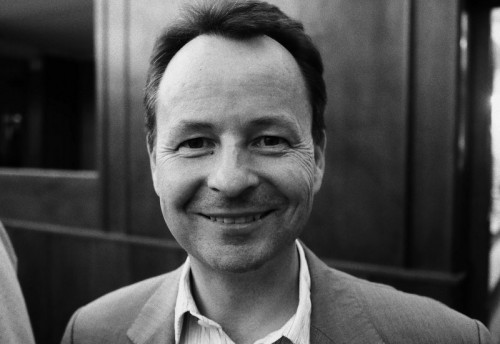
Austria is making some wonderful wines at the moment, and this tasting was a chance to look back at some of the Rieslings from ‘Erste Lagens’ (which translates as ‘Premier Crus’) in the winegrowing area unofficially known as the Danube area, from the regions that are taking part in this exercise of delineating the top vineyards. It was presented by Michi Moosbrugger of Schloss Gobelsburg, who gave a very clear introduction to the project.
Winemaking in Austria is concentrated in the east of the country, with 18 specific regions. However, the vineyards can be divided into three broad growing areas: Steiermark in the south, then everything south of the Danube (including Burgenland, concentrating on red wine and some sweet wines), and then everything that is north of the Danube (focusing mainly on Riesling and Gruner Veltliner, the subject of this tasting). This Danube area is the most westerly, and it split into Kremstal, Kamptal, Wachau, Wagram and Traisental.
The main valley of the Danube is the Wachau, and then there are the side valleys: Traisen, Krems and Kamp. The differences within the appellations are probably more significant than the differences between them. There are important differences between the lower ends of the valleys and the top, where winegrowing stops. It’s around 1-1.2 C, which is quite a lot.
Altogether the Danube area covers around 10 000 hectares of vineyards. (Austria in total is c 50 000 hectares, same as Burgundy.). In terms of planting, there is 55% Grüner Veltliner, 10% Riesling and 15% Zwiegelt (from the 2000s boom in red wine production).
Until World War II, most wines were field blends. The overall structure of Austrian vineyards was based on field blends, with many varieties mixed together. Everything was sold by village appellations, and very few single vineyards were mentioned on labels. After the war there was a dramatic change in Austrian vineyards, with a transition from field blends to varietal plantings, and wines were sold by grape variety. As people didn’t know what the future would bring, they decided to plant everything that they had in the field blends as single varietal wines. This began to be refined in the 1970s, and by the end of the 1980s only Grüner Veltliner and Riesling were left as significant plantings in the Danube area.
The current appellation system that is still under development began in the 2000s. It is a process that takes time, and all involved are showing the requisite patience. In 2002 Austria began with the first DAC appellation, and now there are some 10 of them, with more in the pipeline. In the Danube area a three-tier system has emerged: regional, village (Orstwein) and single vineyard (known as Ried), and within this single vineyard segment, the concepts of premier and grand cru vineyards are now being teased out. So far, Kamptal, Traisental and Kremstal are on board; Wagram is still developing the system for themselves; and Wachau is not yet involved.
In 1992 the Österreichischer Traditionsweingüter (OTW) was founded to help begin the classification of vineyard sites. There was a lot of tasting of wines, and consultation with geologists and scientists. In all, the process took 17 years to come up with the classification of the Erste Lagen (the premier crus). Now they are in a process of delineating grand crus (Grosses Lagen). This will take perhaps another decade, and then they will translate it into the legislation. The winegrowers are leading the process. ‘If we let politics into this game, a lot of shit will happen,’ says Michi. ‘We are taking a lot of time in order to do it properly. It’s a generational process.’
So the current structure is that there is an appellation system of region, village and single vineyards. Then, of these single vineyards, be Erste and Grosse lagen (the top 3-5%).
It is a thorough process. They have defined relevant factors for the classification, which they break down as content factors, economic factors and quality factors. Content includes historical records, subjective relevance (the individual grower’s assessment), intersubjective relevance (the collective assessment of the growers), varying relevance (the variance among the wines from the vineyard) and quantitative relevance (the number of producers making a separate wine from the vineyard). Economics include the price fetched for wines from each site. Quality factors include media and expert ratings for all wines out of the vineyard. The variation of these ratings and continuity are important, too. The producers also taste all these wines and this is considered.
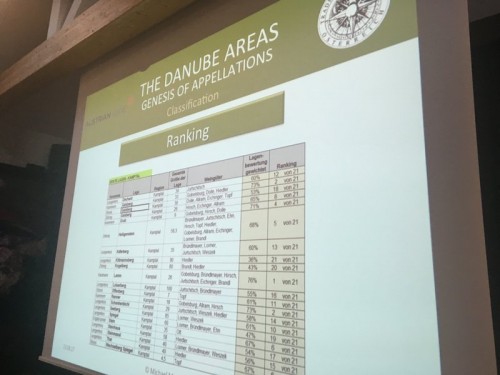
All these factors go into an evaluation sheet, and a system has been built up to process the data. There’s an average score for each vineyard, plus the variances and the sorting. This helps produce the classification strength.
In all, there are 5400 vineyards in Austria, with 2500 single vineyards in the Danube area. So this is a lot of work, potentially.
In 2009 they started with 53 vineyards as the base. In 2011 they began a collaboration with the VDP (in Germany) and the STK Steiermark to try to harmonise the process. Now we are looking at 61 single vineyards (Rieden) which is 16% of the production area. In order to use the Erste Lagen classification you need to be a member or an associate of the TGW.
Wachau roducers have their own classification that’s not based on vineyards, but instead on must weights after pressing. For the moment they aren’t joining. ‘I am on good terms with most of the Wachau producers,’ says Michi. ‘We are doing our thing and they are doing their thing. They are not doing a vineyard classification at the moment.’ This is a bit of a shame, because the patient way that this vineyard classification is being developed is a model for emerging appellation systems worldwide.
THE WINES
Malat Ried Further Gottschelle Grüner Veltliner 2012 Kremstal, Austria
Nice density here with fresh citrus and pear fruit, with hints of pepper and a lovely mid-palate fruit sweetness. Has good concentration of flavour and fresh, mineral, citrus fruit on the finish. Lovely focus. 91/100
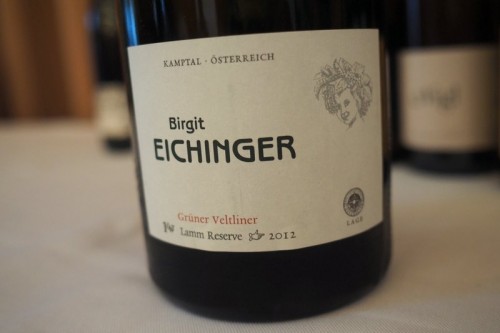
Birgit Eichinger Ried Kammerner Lamm Grüner Veltliner 2012 Kamptal, Austria
Subtly waxy with a dense, mineral citrus core. White pepper and juicy acidity provide a supporting role with brightness, purity and focus. There’s a lovely sweet crystalline fruit core here. Very refined and nuanced. 93/100
Ehn Ried Langenloiser Spiegel Grüner Veltiner 2012 Kamptal, Austria
Aromatic with a slight creaminess, as well as detailed tangerine and pear fruit. Crisp and complex with finesse and delicate, refined citrus fruit. This is pretty harmonious and really pretty. 93/100
Johann Topf Ried Strasser Offenberg Grüner Veltiliner 2012 Kamptal, Austria
Fine and harmonious with a sweet pear and white peach core to the ripe fruit on the palate. Quite generous but not at all flabby with good acidity and a fresh, slightly citrus pithy finish. 91/100
Nigl Ried Senftenberger Pellingen Grüner Veltliner 2012 Kremstal, Austria
This is lovely: there’s some tangerine and canteloup melon richness, backed up by crystalline citrus fruit, a hint of pepper and good acidity. There’s a lovely depth to the palate with nice precision and brightness. Attractive stuff. 92/100
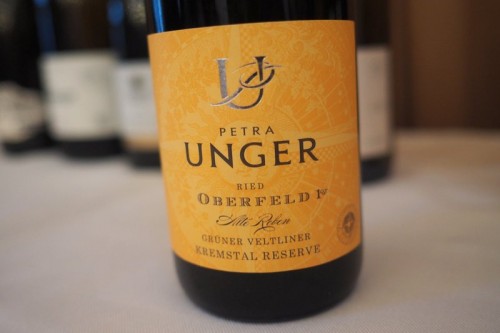
Petra Unger Ried Further Oberfeld Grüner Veltliner 2012 Kremstal, Austria
This has a lovely white pepper edge to the pear and melon fruit, with some citrus brightness. There’s a good concentration of fruit here, and a sense of harmony. Developing beautifully with some subtle toasty richness. 93/100
Ott Ried Feuersbrunner Spiegel Grüner Veltliner 2012 Wagram, Austria
Harmonious with a mellow richness and concentration, showing pear and peach fruit overlaid on a citrus background. It’s dry, but there’s a sucrosity and generosity here that’s really appealing. 92/100
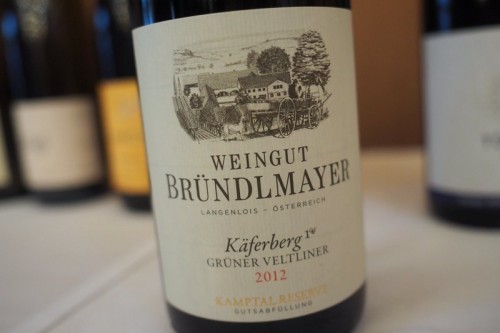
Bründlmayer Ried Langenloiser Käferberg Grüner Veltliner 2012 Kamptal, Austria
Finely aromatic with some spicy pear and citrus fruit, as well as some peppery structure on the palate, under the fresh, slightly grippy fruit. This is serious and complex, with some fine toasty richness and a grainy, peppery finish. 93/100
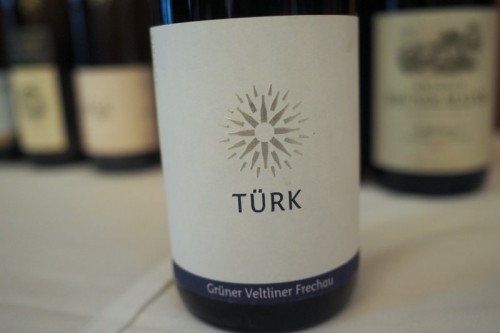
Türk Ried Kremser Frechau Grüner Veltliner 2012 Kremstal, Austria
Concentrated, fresh, vivid and very peppery, with lovely complexity and harmony. Tangerine, herbs and bright white pepper detail add interest to the palate. Finishes very lively and expressive. Lovely wine. 94/100
Karl Fritsch Ried Kirchberger Schlossberg Grüner Veltliner 2012 Austria
There’s some toasty, nutty richness here, with a sweet fruit core and some nice development. Has warmth on the mid-palate and generous pear and melon fruit. Seems a touch sweet. 91/100
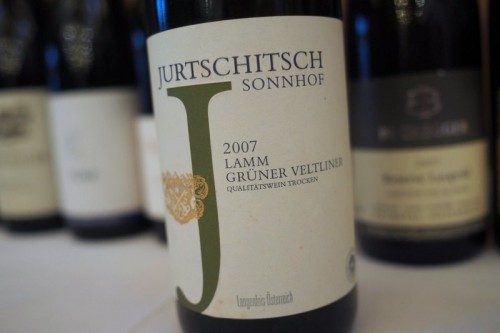
Jurtschitsch Ried Kammerer Lamm Grüner Veltliner 2007 Kamptal, Austria
Lovely development here with toast and pepper detail as well as crystalline citrus fruits and a hint of herbiness. Harmonious and broad with a hint of pith on the sweet, long finish. Mature and very attractive. 92/100
Buchegger Ried Gedersdorfer Vordenberg Grüner Veltliner 2007 Kremstal, Austria
Refined and peppery on the nose, with some lovely sweet citrus and pear notes. The palate is fresh and beautifully expressive with nice weight to the fruit. Showing some attractive sweet pear and melon fruit richness, but still very focused and fresh. 94/100
Leth Ried Felser Scheiben Grüner Veltliner 2007 Wagram, Austria
Very fresh with youthful citrus and pear fruit, as well as some peppery detail. Bright and juicy with good acidity. So primary for a 10 year old wine, and really delicious. 93/100
Neumayer Ried Inzersdorfer Zwirch Grüner Veltliner 2007 Traisental, Austria
From a screwcapped magnum. There’s a slightly plasticky, herby edge to the nose, and the palate is tight, pithy and primary. Lots of citrus pith here. Not very harmonious, but still youthful. 89/100
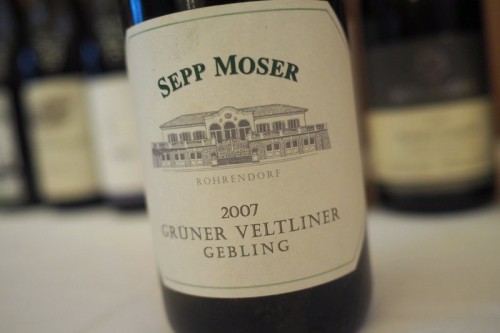
Sepp Moser Ried Rohrendorfer Gebling Grüner Veltliner 2007 Kremstal, Austria
Complex, slightly smoky, and surprisingly youthful, with a fresh, juicy, herb and pepper-tinged citrus fruit core. Complex and bright with nice precision. Developing very nicely with a good future ahead of it. 93/100
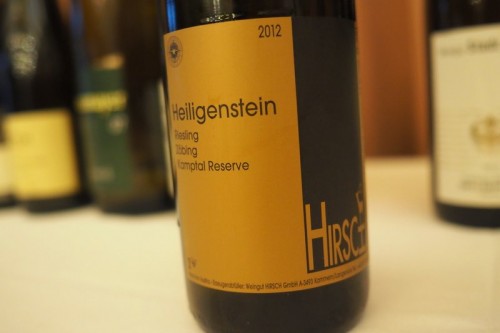
Hirsch Ried Zobinger Heiligenstein Riesling 2012 Kamptal, Austria
Beautifully focused with concentration and richness. Has lovely, concentrated sweet citrus fruit with hints of melon and honey, some spice, and crisp acidity. Really lovely wine, drinking beautifully. 94/100
Stadt Krems Ried Steiner Grillenparz Riesling 2012 Kremstal, Austria
Fresh and intense with lovely citrus fruits. There’s some grapefruit pith adding a savoury detail, but the core is generous citrus tightly framed by keen acidity. There’s finesse to this wine. Harmonious. 93/100
Brandl Ried Zobinger Kobelberg Riesling 2012 Kamptal, Austria
Taut, primary and fresh with a hint of pithiness and keen, dry citrus fruits. Has some herbal characters on the finish. Bright, linear, lemony and primary. 92/100
Stift Göttweig Ried Further Silberbichl Riesling 2012 Kremstal, Austria
Pronounced tangerine, lemon and grapefruit pith here. Youthful and still compact and bright, with the fruit tightly furled and waiting to come out. Lovely purity. 92/100
Hermann Moser Ried Rohrendorfer Gebling Riesling 2012 Kremstal, Austria
Lively and a bit spicy with crisp, focused citrus fruits. Linear but with a bit of crystalline fruit richness. Still compact and a bit backward, with keen acidity. A precise style with potential for development. 93/100
Weszeli Ried Langenloiser Seeberg Riesling 2012 Kamptal, Austria
Fresh, bright, pure, vivid and lemony with keen acidity. Still primary and youthful, with lovely dense fruit, and yet a sense of lightness. Very acidic. 91/100
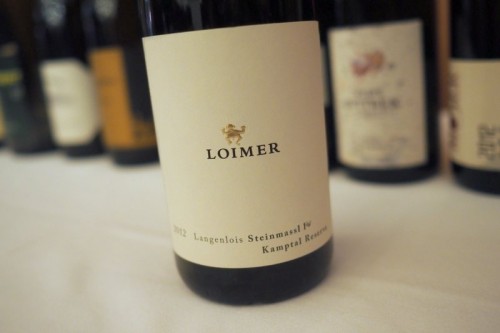
Fred Loimer Ried Langenloiser Steinmassl Riesling 2012 Kamptal, Austria
Linear, pure and focused with taut, compact citrus fruit and hints of wax and herbs. There’s a lovely complexity to this wine, with some pithy bitterness on the finish. Give it time to open out and show its best. 93/100
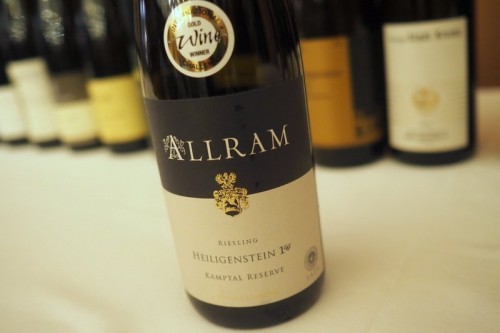
Allram Ried Zobinger Heiligenstein Riesling 2012 Kamptal, Austria
Delicate tangerines and lemons on the nose. Very harmonious and elegant on the palate with nice acidity supporting pretty fruit. There’s a precision and purity to this wine: it’s generous, but still tightly focused. Juicy, fine finish. Quite lovely. 94/100
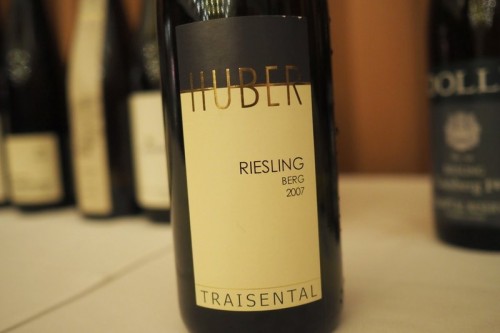
Markus Huber Ried Reichersdorfer Berg Riesling 2007 Traisental, Austria
Complex, spicy, lively and intense with hints of pepper and citrus zest, as well as a core of pure citrus fruits. Lovely purity and precision here with amazing focus. Still quite youthful with a bit of a sweetness to the fruit with a touch of development. Lovely wine. 95/100
Dolle Ried Strasser Gaisberg Riesling 2007 Kamptal, Austria
Compact with nice dense citrus fruit, with a hint of honey and toast. Nice weight and balance here. Not as evolved as you might expect with a delicious weight to it. 92/100
Schmid Stratzinger Sunogeln Riesling 2007 Kremstal, Austria
Fresh and bright with a good concentration of citrus and pear fruit. Pure and bright with some spicy complexity. The acidity is beautifully integrated into the wine. Very impressive stuff, with a fresh, linear citrussy finish. 94/100
Proidl Ried Senftenberger Ehrenfells Riesling 2007 Kremstal, Austria
This is really fresh, with deliciously focused, pure citrus fruit. Some crystalline fruit complexity and richness. Delivers a pure, long stream of lemon and mandarin fruit that just keeps on going. Ageing beautifully. 94/100
Wess Ried Steiner Pfaffenberg Riesling 2007 Kremstal, Austria
Nut, spice, wax and pepper complexity here complementing the green apple and citrus fruit. Linear and delicious, and showing the first stages of complexity from the ageing process. Very appealing with a pithy, slightly bitter finish. 92/100
Mantlerhof Ried Gedersdorfer Wieland Riesling 2007 Kremstal, Austria
Generous with honey, nuts, spice and lemon curd flavours. Showing a bit of development here. Rounded but with good acidity and some spiciness. Very interesting. 92/100
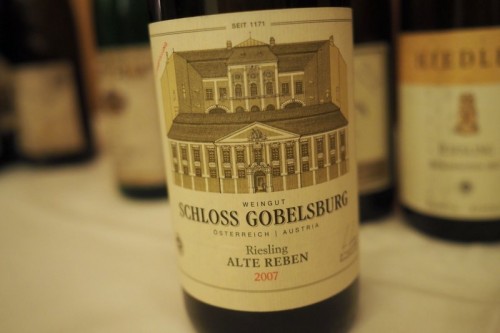
Schloss Gobelsburg Ried Kammerner Gaisberg Riesling 2007 Kamptal, Austria
Crisp, tight and expressive with lovely intensity to the bright citrus fruit. Intense, fresh and really complex with lovely acidity and a fresh, long lemony finish. This has a long way to go but is already showing some real complexity. 95/100
Salomon Ried Steiner Kögl Riesling 2007 Kremstal, Austria
Concentrated and with some density to the pithy, crystalline, lemony fruit. Has a brightness under the sweet fruit. Real finesse with a bit of development. 93/100
Hiedler Ried Zöbinger Heiligenstein Riesling 2007 Kamptal, Austria
Some nutty, waxy, slightly toasty development here along with some generous honeyed citrus fruit. It’s quite delicious in a broader style with a fresh lemony, spicy finish. Lovely. 93/100
Geyerhof Ried Oberfucha Goldberg Riesling 2007 Kremstal, Austria
Marmalade and toast on the nose with a bit of apple and pear richness, alongside some spicy citrus fruit. Showing a little development, and drinking very well now. 92/100
Find these wines with wine-searcher.com
1 Comment on In Austria: tasting exciting older 1er cru wines from the Österreichischer Traditionsweingüter members
Excellent and precise article. Any thoughts on the comparison between the Austrian Reislings, such as the citrus-tinged Salomon Ried Steiner Kögl Riesling 2007, and their Australian equivalents, such as the Alkoomi Black Label Frankland River Riesling 2014?